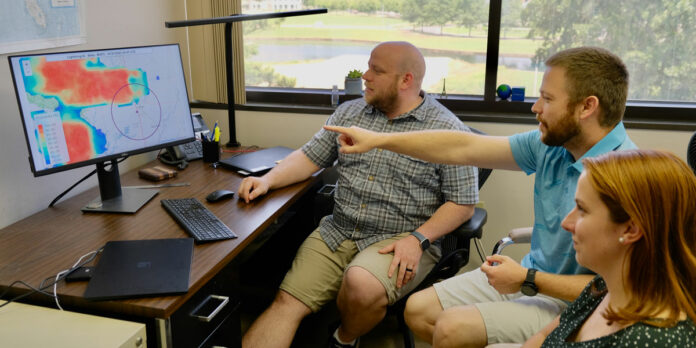HUNTSVILLE – On the afternoon of July 21, more than 35,000 people were denied entry to Rock the South’s outdoor country music festival in Cullman, due to the threat of lightning in the area.
New lightning prediction technology developed by researchers from the University of Alabama in Huntsville’s Earth System Science Center made its debut to forecast the threat at the event.
UAH Research Scientist Dr. Andrew White, through a cooperative agreement between the Marshall Space Flight Center and UAH, developed the NASA Short-term Prediction Research and Transition Center’s Lightning-Artificial Intelligence (AI) tool known as SPoRT which can predict the probability of the threat of lightning up to 15 minutes before an actual strike occurs. The product was developed using machine-learning techniques along with consulting support from fellow UAH Research Scientist Dr. Robert Junod.
“The machine-learning model was trained on a lot of data from previous events to learn the trends and patterns that lead to lightning initiation,” White said. “It then applies what it has learned to make predictions on future events.”
Meteorologists Huntir Cramer and Dan Dixon from the National Weather Service of Huntsville were stationed at the Cullman County Emergency Management Agency Mobile Emergency Operations Center at the event to provide operational weather support. Both Cramer and Dixon utilized SPoRT’s Lightning-AI product to specifically forecast the threat of lightning.
“Summertime pop-up convection can happen very quickly, so having any type of advance warning is extremely helpful, especially with large outdoor events taking place,” Cramer said.
SPoRT’s Lightning Viewer houses a suite of lightning products, including the Lightning-AI that enabled Cramer and Dixon to establish a defined mileage perimeter around Rock the South.
“One storm that developed to the south-southwest of the venue ended up congealing with a storm just to the north of it and started generating a lot of lightning,” Dixon said. “As we saw the product’s probability of lightning increasing closer to the range ring around the venue, we knew this would cause a risk to the public’s safety.”
Dixon and Cramer alerted the Cullman County EMA that SPoRT’s Lightning-AI product was indicating a 50% chance of lightning striking close to the venue near 3 p.m. The information led event coordinators to bar concertgoers from entering the venue so they could shelter in their vehicles.
Lightning was noted within five miles of the venue during the time it was closed.
Cramer and Dixon continued monitoring the area until the threat of lightning was substantially decreasing by 6 p.m. The event coordinators opened the venue at 6:30.
After the event, NASA SPoRT’s Engagement Training and Assessment team of UAH research associate Kelley Murphy and the National Weather Service’s Application Integrations Meteorologist Kris White, worked with Cramer and Dixon to collect feedback on how well the product performed.
“We can use feedback from Huntir and Dan to tailor the product to their operational needs,” Murphy said. “We value their input and want to make sure that products like Lightning-AI are easy to use and help them with their forecasting and decision support tasks.”
NASA SPoRT Lightning-AI is only active near NASA Centers in support of NASA emergency managers. Its utility, however, has grown outside of NASA to support National Weather Service offices and their partners in areas near NASA facilities.
Don’t miss out! Subscribe to our email newsletter to have all our smart stories delivered to your inbox.



